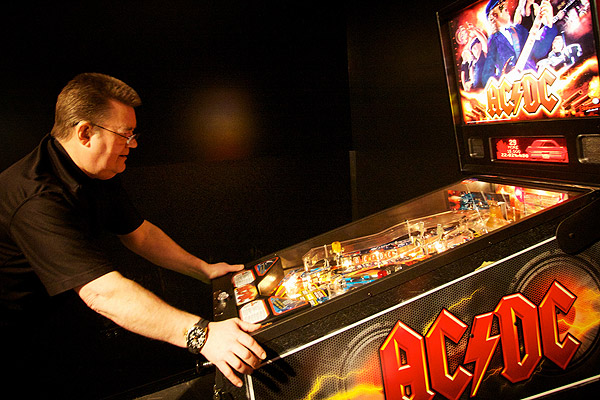
* Miles Raymer visits the Stern Pinball Factory, the last stand of Chicago's former glory as "the global capital of pinball manufacturing," which Raymer attributes in part to the early-20th-century popularity of bagatelle.
Ritchie's official biography includes a lengthy list of technological firsts; machines he designed boast features that have since become standard in pinball's technological lexicon, and Ritchie-designed machines like High Speed and Terminator 2: Judgment Day are considered classics among pinball fanatics. His designs have outsold all other designers, and during pinball's heyday Ritchie, a musician who picked up the guitar the day after he saw the Beatles on Ed Sullivan in 1963, was sort of the industry's rock star figure. High Speed, for instance, is based on a high-speed chase that Ritchie once had with police while driving a Porsche.
* Steve Ritchie's nickname is "The King of Flow." I'm awful at pinball so I have no idea what that means. Apparently two of the criteria for a great pinball game are "flow" and a "rules set":
To this day, pinball still provides me a rush that I can’t get from video games. Part of it is the live physics. I don’t care how elegantly or intricately designed a video game is, it still can’t touch the flow of keeping a steel ball in play, defying gravity, and aiming with precision, sequence and finesse. But the other angle of pinball is how you interact with the rule set of the game. Video games are typically linear. You are placed in a situation, you deal with it, and you are presented with a new situation, typically a little more challenging. The set of the things you can do in each situation is necessarily limited. It’s a bounded subset of the overall possibilities of the game.
(That's from a nice piece by UX expert, button historian, and creative director Bill DeRouchey.)
* Marcin Wichary has a photographic tour of Stern Pinball.
* Meanwhile, today the Tribune has an obit for an older pinball legend, Bally vet Steven Kordek, who died at the age of 100 last week (h/t Adam Doster).
Then 26, he had never designed a game himself. So he borrowed a concept — the flipper — from a competitor. But instead of having six flippers in the upper playing field, he reduced it to two electrified flippers at the bottom, which resulted in more power to rocket the ball back to the top.
"What Steve did was revolutionize the game of pinball," DeMar said. "It now became a defensive battle."
Here's an interview with Kordek and others at the Bally factory in 1994:
Photograph: Marcin Wichary (CC by 2.0)


